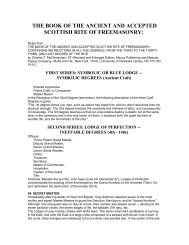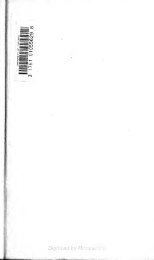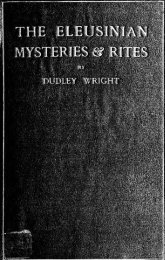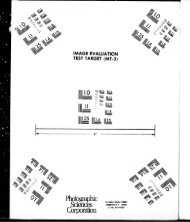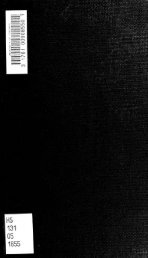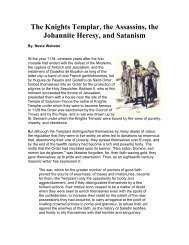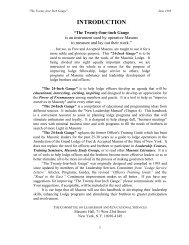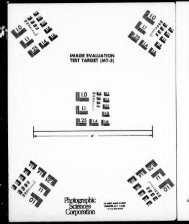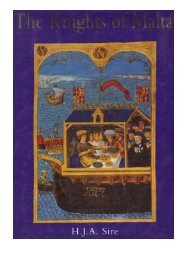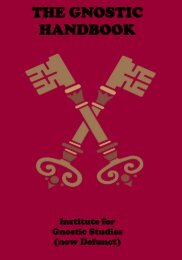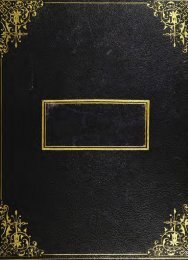Scottish Rite Masonry Illustrated - The Masonic Trowel
Scottish Rite Masonry Illustrated - The Masonic Trowel
Scottish Rite Masonry Illustrated - The Masonic Trowel
Create successful ePaper yourself
Turn your PDF publications into a flip-book with our unique Google optimized e-Paper software.
284 KNIGHTS OP ST. ANDREw.<br />
of Ramsay’s’” <strong>Rite</strong> which was introduced about the year<br />
1728, and was called Eccossais, or Scotch <strong>Masonry</strong>. it<br />
is founded on Chivalric <strong>Masonry</strong> or the <strong>Masonry</strong> of t~ic<br />
Crusades, and gives a history of the events that led to<br />
the union of 1 the Chivalric orders with Freemasonry.<br />
<strong>The</strong> ceremony of reception [initiation ~ is brief; the<br />
instruction full. This grade is preparatory to the<br />
liadosh and was introduced into the Ancient and Accepted<br />
rite by Frederick the Great in 1786.<br />
In this degree my brother, you are admitted into the<br />
true Eden or dominion of everlasting truth and fraternity.<br />
<strong>The</strong>re you learn what perseverance can do, and in<br />
the repose of your heartand mind you find the ultimate<br />
result of our Master’s doctrine, which for so many, is the<br />
text cif a thousand vain and false theories. It is for that<br />
very same result that Freemasonry has been assailed,<br />
both by kingly and priestly usurpers, by Atheists and<br />
narrow-minded sectarians. This degree my brother, is<br />
usually conferred by communication.<br />
Nets 8SS.—’Ramaay, Andrew, Michael. Commonly called the Chevalier<br />
itamasy. He was burn at Ayr, in Scotland. Jnne 9. 1668. HIs<br />
father was a baker, hut being a possessor of considerable property was<br />
enabled to give his sun a ilbersi education. He was accordingly sent<br />
to school in his native burgh, and afterwards to the University of<br />
itdinhurg, where he was diatingulahed for his abilities and diligence.<br />
In iWO he was intrusted with the education of the two sons of the Sari<br />
of wenayss. Subsequently, becoming unsettled in his reilgions opinions.<br />
he resigned that employment and went to Holland, residing for some<br />
time at Leydon. <strong>The</strong>re he became acquainted with Pierre Poiret. one<br />
of the most celebratedtteachera of the mystic theology which then prevailed<br />
on the continenL From him Ramasy learned the principal tenets<br />
of that system, and It is not unreasonahis to suppose that ha was thus<br />
indoctrinated wIth that love of mystical speculation which he auhsqquently<br />
developed as the Inventor ol Nasonic degrees, and as the founder<br />
of a <strong>Masonic</strong> aite. In 1710 he visited the celebrated Pension. Archhiahop<br />
of Cambray, of whose mystical tendenciea he had heard, and met<br />
with a cordIal receptIon. <strong>The</strong> archbishop invited Ranasay to become his<br />
guest, and in six months he was converted to the Catholic faith. Pension<br />
procured for hIm the preceptorship of the Duc de Chatean-Thierry and<br />
the Prince do Turenne. As a reward for his services in that’ capacity he<br />
was made a knight of the Order of St. lasarus. whence he receIved<br />
the title of ‘chevalier,’ by which he was usually known. He was subsequently<br />
selected by James Ill., the Pretender, as the lutor of his two<br />
sons, Charles Edward and Henry tha former of whom beosme afterwarde<br />
the Toung Pretender, and the latter the cardinal York. Fur this purpose<br />
be repaired, in 1724, to Rome. Dut the political and religious<br />
intrigue, of that court becams distasteful to him, and in a short tims<br />
he obtained permission to return to France. In 1125 he visited England,<br />
and became an inmate of the fami~~ of the Duke of Ar9j~.’—Maeksv’s<br />
aa~siopadia ef Freemasonry, Arti 3amsa~, Andrew<br />
KNIGHTS OF ST. ANDREW. 235<br />
DECORATIONS :—In this degree, the lodge is Ilung with<br />
red tapestry, supported by white columns. <strong>The</strong> seats of<br />
the Master and of the two Wardens are of red cloth<br />
with gold fringe; those of the Knights are blue. At<br />
each angle of the hall is a Cross of St. Andrew. In front<br />
of each cross are four lights in a linc, making sixteen<br />
lights. <strong>The</strong> total number of lights in this lodge is<br />
eighty-one, viz.: Two on the altar, seven groups of nine<br />
and the first sixteen in front of the crosses.<br />
TITLES :—This lodge is styled Grand Lodge. <strong>The</strong><br />
Mastcr is called Patriarch and the Knights, Respectable<br />
Masters.<br />
CLOTHING :—A red robe. Order a scarf of crimson.<br />
At the bottom of the scarf is the jewel, fastened by a<br />
rosette of dark green, edged with red. When a collar<br />
is worn it must be of green, edged with red. <strong>The</strong><br />
Knights wear a sash of white silk with gold fringe.<br />
JEWEL :—Ts a compass within three triangles, and<br />
these within a single triangle. Beneath the grand<br />
triangle is a reversed square, a poniard in the angle of<br />
the square. When a collar is worn, the jewel is a cross<br />
of St. Andrew, surmounled by a closed crown. In thc<br />
centre and on the crosslet is a pin&apple or a J.:. within<br />
a triangle in the middle of a ring. To this ring is supended<br />
a key which hangs between the two inferior<br />
hranches of the cross. At the extremity of the arms<br />
of the cross are the initials B. .,T. .M. .N..



